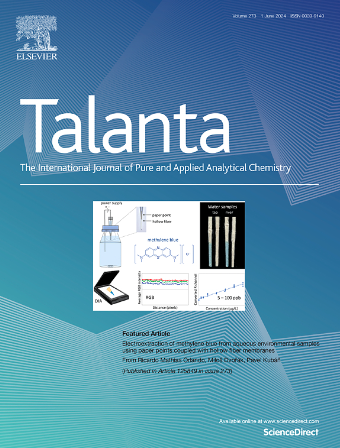采用苏丹丹III功能化Fe3O4固相萃取分离富集氢化植物油中镍(II)
IF 5.6
1区 化学
Q1 CHEMISTRY, ANALYTICAL
引用次数: 0
摘要
本研究提出了一种分离/预富集氢化植物油中Ni(II)的新方法。采用红外光谱(FTIR)和扫描电镜(SEM)表征的Sudan III改性Fe3O4作为固相萃取剂。采用中心复合设计对影响Ni(II)吸附洗脱的关键参数进行了优化。最佳条件为:涡旋时间58.3 s,吸附剂质量0.22 g,吸附剂体积19.1 mL,吸附剂质量0.86 mol L−1 HNO3溶液6 mL,涡旋时间95 s。该方法的定量限和定量限分别为35.9和119.6 μ kg−1。预富集系数为3.2,采样频率为23.4 h−1。采用有机金属镍标准品进行验证,回收率为97±4%,精密度为4.1%。通过对商品氢化植物油的分析,证明了该方法的适用性,其回收率在93.0 ~ 108.6%之间。使用分析绿色计算器评估环境可持续性,结果绿色得分为0.51。该方法为复杂油质基质中痕量Ni(II)的分析提供了一种灵敏、高效、环保的方法。本文章由计算机程序翻译,如有差异,请以英文原文为准。

A novel solid-phase extraction method for separation and preconcentration of Nickel(II) in hydrogenated vegetable oils using Sudan III functionalized Fe3O4
This study presents a novel approach for separation/preconcentration of Ni(II) from hydrogenated vegetable oils prior to FAAS detection. Sudan III modified Fe3O4 that was characterized by FTIR and SEM, was utilized as solid phase extractor. Critical parameters effective on sorption and elution of Ni(II) were optimized using central composite design. The optimum conditions were 58.3 s vortexing time, 0.22 g sorbent mass and 19.1 mL sample volume for sorption and 6 mL of 0.86 mol L−1 HNO3 with 95 s vortexing time for elution. LOD and LOQ of the method were 35.9 μg kg−1 and 119.6 μg kg−1, respectively. Preconcentration factor was obtained as 3.2 and sample frequency was 23.4 h−1. Organometallic Ni standard was used in validation and recovery was 97 ± 4 % with 4.1 % precision. Applicability was proved by the analysis of commercial hydrogenated vegetable oils with recoveries between 93.0 and 108.6 %. Environmental sustainability was assessed using the Analytical GREENness calculator, resulting in a greenness score of 0.51. This method offers a sensitive, efficient, and eco-friendly approach for trace Ni(II) analysis in complex oily matrixes.
求助全文
通过发布文献求助,成功后即可免费获取论文全文。
去求助
来源期刊

Talanta
化学-分析化学
CiteScore
12.30
自引率
4.90%
发文量
861
审稿时长
29 days
期刊介绍:
Talanta provides a forum for the publication of original research papers, short communications, and critical reviews in all branches of pure and applied analytical chemistry. Papers are evaluated based on established guidelines, including the fundamental nature of the study, scientific novelty, substantial improvement or advantage over existing technology or methods, and demonstrated analytical applicability. Original research papers on fundamental studies, and on novel sensor and instrumentation developments, are encouraged. Novel or improved applications in areas such as clinical and biological chemistry, environmental analysis, geochemistry, materials science and engineering, and analytical platforms for omics development are welcome.
Analytical performance of methods should be determined, including interference and matrix effects, and methods should be validated by comparison with a standard method, or analysis of a certified reference material. Simple spiking recoveries may not be sufficient. The developed method should especially comprise information on selectivity, sensitivity, detection limits, accuracy, and reliability. However, applying official validation or robustness studies to a routine method or technique does not necessarily constitute novelty. Proper statistical treatment of the data should be provided. Relevant literature should be cited, including related publications by the authors, and authors should discuss how their proposed methodology compares with previously reported methods.
 求助内容:
求助内容: 应助结果提醒方式:
应助结果提醒方式:


